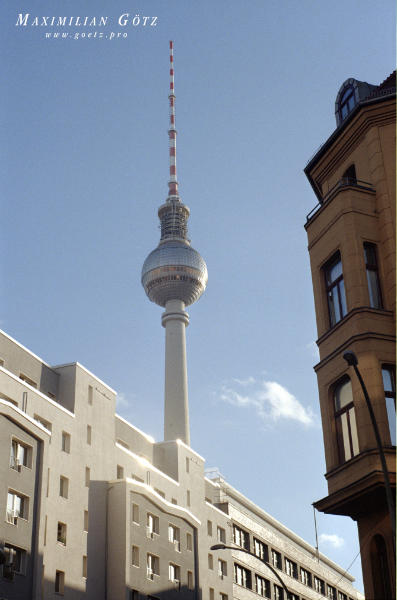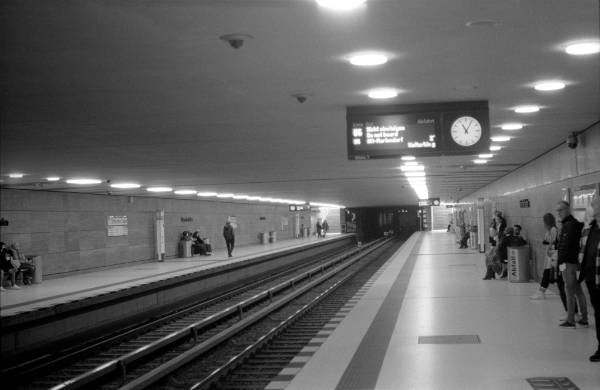Maximilian Götz
www.goetz.pro
The Zeiss-Ikon Contessa LK Camera
Published 30 May 2024, filed under "cameras"
The Zeiss-Ikon Contessa LK is your typical 35mm viewfinder camera from the 1960s. It features scale focussing, a fixed lens, a selenium light meter and a simple viewfinder. Cameras like this one can be had for next to nothing these days – I bought mine for a whole 10€, if I remember correctly, at a flea market roughly two years ago. I bought it out of curiosity and because I wondered whether it would be worth a try – could a camera this cheap be worth shooting practically?
Overview
Overall, the build quality of this camera is amazing. It weighs more than one would probably expect when looking at it and it is fully made from metal. All the dials, including the de-clicked aperture one, turn very smoothly and feel great, especially the one for focussing at the very front of the lens. The camera is very small and easily fits into most jacket pockets. It is great for carrying around casually. Being a point-and-shoot camera, this is to be expected. Amazingly, my copy is totally light tight, even after all the years. It does not appear like anyone put new light seals into it and I have never seen a light leak on any of my photos with it. Even the shutter speeds run quite accurately, speaking for its reliability. Film is advanced using a winding lever that retracts into the camera body, leaving only a small metal tab out which one can place their thumb at to start advancing. It advances in one full stroke and cocks the shutter automatically.
As for accessories, there is the included brown leather case with a strap.
Lens
The Contessa LK comes with a Carl Zeiss Tessar 50mm f2.8 fixed lens installed in a Prontor 500 LK shutter. Said shutter only goes from 1/15s to 1/500s plus bulb, limiting the photographer to the latter setting for exposures longer than 1/15s. This is annoying when working under dim light and with a tripod, although this camera was never meant to be used for this kind of work. Nevertheless, the shutter is really quiet and as there is no mirror to flip up inside the camera when taking a photo, there is very little vibration.
The lens itself is single coated but performs very well, especially when compared to some other competing offerings at the time. It delivers sharp pictures. A typical Zeiss lens!

Sample photo, taken in Berlin, 2022
At f2.8, it is certainly not the fastest 50mm lens. However, it would be unreasonable to expect anything faster here. This was sold as a medium-priced camera and it only allows for scale focussing. Getting anything properly into focus at, say, f1.4 with scale focussing can be a bit of a challenge. The lens stops down all the way to f22. The lens has a thread for really tiny 27mm filters. It can be hard to find (modern) filters this small, not even my set of adapter rings goes this small!
Features
On the top plate of the camera, one finds flash sync terminals, hidden under a swiveling door, a light meter readout, a cold shoe as well as a rotary exposure counter with the shutter button in the middle. Zeiss-Ikon expected you to reset the exposure counter manually by setting it to frame 36. From there, it would count down as you advance through the roll. The bottom plate has the rewind button, a retracting rewind crank and a tripod mount.
In the viewfinder, there are bright framing lines corresponding to the 50mm lens. One can also see the selected aperture and shutter speed from within it. At the top, there is a second light meter readout. As this is a viewfinder camera, there are no focussing aids whatsoever in the viewfinder. The glass has a bit of a rose tint to it.
Light Meter
The light meter is based around a big selenium cell at the front of the camera. As is quite typical with selenium-based light meters1, the one in my Contessa LK seems to have failed. There is no door on the camera to save it from light exposure when not in use so failure is to be expected. The meter is coupled to the exposure dials. One sets the film speed on the lens with options ranging from ASA 10 through to 800. A DIN scale is available, too. Selenium light meters need no battery and as the camera is fully mechanical, there is no battery compartment anywhere on it.
Practical Use
As mentioned above, the camera is so small it can be carried around for casual shooting in the pocket. That is what it was made for after all. The only thing that makes this camera somewhat annoying to use is its lack of a more serious focussing mechanism. Your best bet is to zone focus. Also, as the selenium light meter tends to wear, one is forced to use an external light meter, which effectively removes its point-and-shoot capability. Back in the day, this would not have been an issue, of course.
Despite those issues, I was quite happy with the photos I took with it on my trips to Berlin and Freiberg in 2022. Still, I prefer a proper SLR or rangefinder camera. There is the Contessa LKE which features a rangefinder mechanism but, apart from that, is mostly the same camera. If you are looking to buy this camera, consider the LKE instead. Although I have not tested it, I imagine the rangefinder would make life a lot easier.

Sample photo, taken in rural Saxony, 2022

Sample photo, taken in Berlin, 2022
Regarding the light meter issue, there are small digital light meters which can be slid into the cold shoe. They might be worth a try.
Footnotes
-
Selenium light meters wear as they are exposed to light. This issue is not specific to this one model of camera, it plagues all selenium light meters. If a selenium cell is protected from light, it does not wear. However, most camera owners did not think so much about whether they should protect their camera’s light meter cells, which is why it is rather common for such cells to have become unusable. ↩
Got any questions or comments? Let me know via mail!